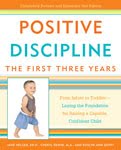 Welcome back to Part #2 of Positive Discipline Tools.
Welcome back to Part #2 of Positive Discipline Tools.
If you didn’t get a chance to read last week’s post you may want for the basics. Again, The Positive Discipline website has great resources, including books and products specifically for preschooler, teenagers, etc. So be sure to research for an extensive studies.
High5: Positive Discipline Tools for Children 0-3 (Part 2)
The following are the exact words from “Top 10 Positive Discipline Tools for Children 0-3” worksheet, provided by Susan Lehman at the 2010 INA Conference. Note that there are many more tools discussed in these books.
5. Redirect
Use redirection to either distract or to direct the behavior from negative to positive.
Examples:
- “It looks like you want to jump. Let’s jump over here where it is safe”
- “Wow did you see that big bird!” (Said with enthusiasm as you gently take the stick out of her hand.)
4. Say What TO Do
Tell your child what you want them to do, instead of what NOT to do and WHY. Young children do not always understand “don’t”.
Examples:
- “Hold my hand so I can help you stay safe in the parking lot.”
- “Leave that wire where is it so the lamp doesn’t fall.”
- “That food is for the doggie, let;s leave it alone.”
- “We need to be quiet in here so the other people can work.”
3. Humor or Make Fun
Young children love to play! So if they resist doing something fun to gain their cooperation.
Examples:
- “Let’s run to the car!”
- “Should we put music on and dance while we clean up?”
- “Can you brush my teeth and then I will brush your teeth?”
2. Involve
Make your children feel like they are capable and can contribute to the family. Involve then in what you’re doing.
Examples:
- Wear your baby on your back or in front while you are cleaning.
- Get your child up at the counter with you in a safe way so he or she can play in the sink to “help” you with the dishes.
- Give them little easy jobs.
1. Model
Children do what they see and say what they hear. Use moments to teach by modeling.
Examples:
- Your child is learning when he or she sees you say sorry, be gentle with pets, clean up a mess, share toys, take a break when you are angry, etc.
One last thought…

“The Wheel of Choice“ by using an empty pie chart, have the child create ways (tools) to help them the next time they face the situation or behavior. They can write or draw the idea in the pie slice, then create another. This is getting the child involved by letting them create the solution.

